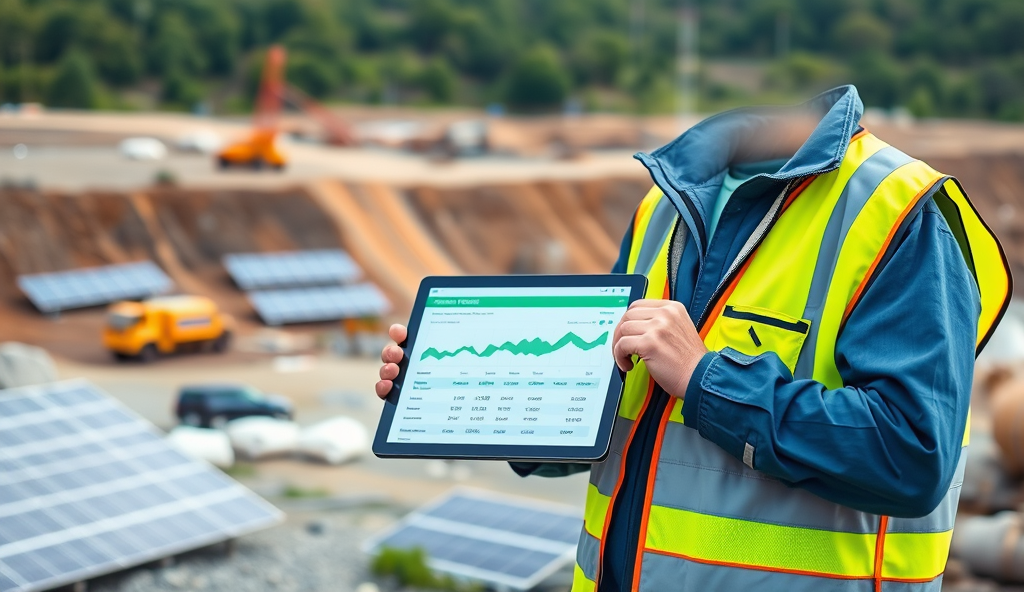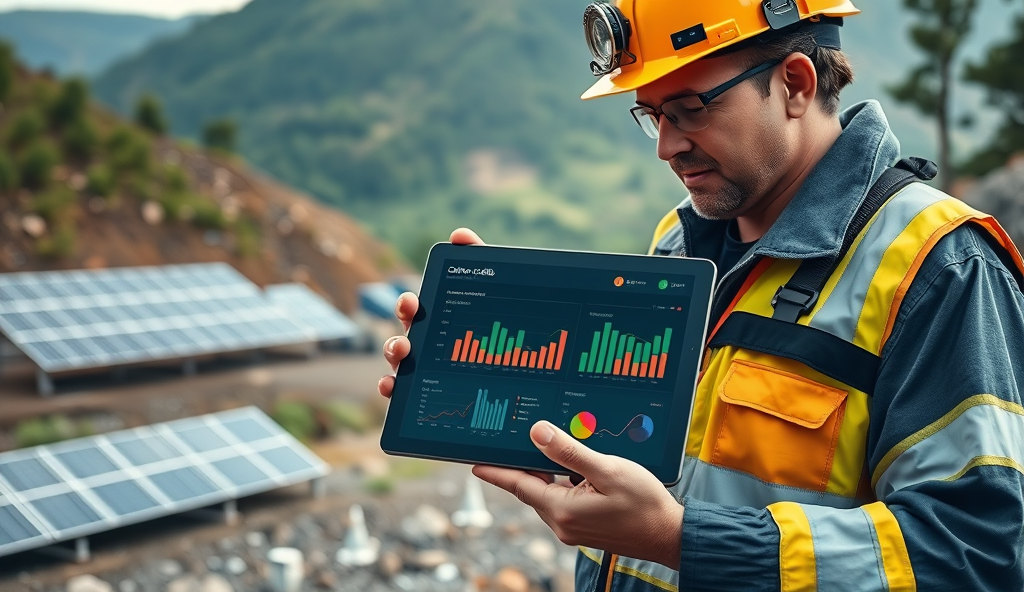Introduction to Carbon Credits for Miners Playbook
The mining sector accounts for 4-7% of global greenhouse gas emissions, making carbon offset strategies for mining companies crucial for climate action. This playbook provides actionable insights on how miners can earn carbon credits while maintaining operational efficiency, addressing both regulatory pressures and stakeholder expectations.
Leading mining companies like BHP and Rio Tinto have already integrated carbon credit programs, reducing emissions by 15-30% in key operations. These real-world examples demonstrate that sustainable mining through carbon credits is not just theoretical but economically viable and scalable across different mining contexts.
Understanding carbon credit eligibility for mining operations requires examining both direct emissions from extraction and indirect emissions from energy use. The next section will explore how these credits function within the mining industry’s unique operational framework, setting the stage for practical implementation strategies.
Key Statistics

Understanding Carbon Credits and Their Importance in Mining
The mining sector accounts for 4-7% of global greenhouse gas emissions making carbon offset strategies for mining companies crucial for climate action.
Carbon credits represent measurable emission reductions, allowing mining companies to compensate for their carbon footprint by funding verified climate projects. Each credit equals one ton of CO2 avoided or removed, creating a market-driven mechanism to align mining operations with global climate goals while maintaining productivity.
For miners, these credits serve as both a regulatory compliance tool and a strategic asset, as seen in Anglo American’s use of reforestation projects to offset 20% of Scope 3 emissions. Beyond compliance, they enhance ESG ratings and stakeholder trust, critical for securing financing and licenses in emission-sensitive jurisdictions.
The mining industry’s transition to low-carbon operations makes carbon credits indispensable, bridging the gap between current emissions and long-term decarbonization targets. The next section will analyze specific carbon credit programs tailored to mining contexts, from renewable energy investments to methane capture initiatives.
Types of Carbon Credit Programs Suitable for Mining Companies
Carbon credits represent measurable emission reductions allowing mining companies to compensate for their carbon footprint by funding verified climate projects.
Mining companies can leverage renewable energy carbon credits by investing in solar or wind projects that displace fossil fuel use, like Rio Tinto’s partnership with a 34MW solar farm in Madagascar. These programs directly reduce Scope 2 emissions while creating long-term energy cost savings, aligning with decarbonization goals discussed earlier.
Methane capture initiatives, such as BHP’s coalbed methane recovery in Queensland, convert potent greenhouse gases into usable energy while generating verifiable credits. Such projects address Scope 1 emissions and often qualify for premium pricing due to methane’s high global warming potential.
Reforestation and land rehabilitation programs, exemplified by Barrick Gold’s 2,000-hectare replanting effort in Tanzania, offset residual emissions while restoring biodiversity. These nature-based solutions complement operational reductions, preparing miners for the upcoming section on calculating site-specific carbon footprints.
Steps to Calculate Carbon Footprint in Mining Operations
Mining companies can leverage renewable energy carbon credits by investing in solar or wind projects that displace fossil fuel use like Rio Tinto’s partnership with a 34MW solar farm in Madagascar.
Accurate carbon footprint calculation begins with categorizing emissions into Scope 1 (direct operations), Scope 2 (purchased energy), and Scope 3 (supply chain), as referenced in Rio Tinto’s renewable energy projects. Mining operators should use standardized tools like the GHG Protocol, supplemented by site-specific data from fuel consumption, electricity bills, and equipment telemetry.
For Scope 1 emissions, measure methane venting and diesel combustion using calibrated sensors, as demonstrated by BHP’s coalbed methane recovery program in Queensland. Scope 2 requires tracking grid electricity consumption and applying regional emission factors, while Scope 3 assessments should include contractor activities and material transport, mirroring Barrick Gold’s supply chain audits.
These calculations establish a baseline for carbon credit eligibility, enabling miners to transition seamlessly into identifying high-impact emission sources. Precise data collection ensures targeted offset strategies, whether through renewable energy investments or methane capture initiatives discussed earlier.
Identifying High-Impact Emission Sources in Mining
Accurate carbon footprint calculation begins with categorizing emissions into Scope 1 (direct operations) Scope 2 (purchased energy) and Scope 3 (supply chain).
With emissions baselines established through Scope 1-3 assessments, mining companies must prioritize mitigation efforts by identifying high-impact sources like diesel-powered haul trucks, which account for 30-50% of operational emissions in open-pit mines. Fugitive methane from coal seams and ventilation systems represents another critical target, as seen in Glencore’s Australian operations where methane capture reduced emissions by 25% annually.
Electricity-intensive processes like grinding and ventilation often dominate Scope 2 footprints, particularly in regions with coal-dependent grids such as South Africa’s Mpumalanga province. Supply chain emissions from explosives manufacturing and ore transport frequently emerge as top Scope 3 contributors, requiring collaboration with suppliers as implemented by Anglo American’s sustainable procurement program.
Pinpointing these hotspots enables miners to allocate resources effectively when selecting carbon credit projects, ensuring offsets deliver maximum climate impact. The next section explores how to match these priority emission sources with appropriate mitigation initiatives, from renewable energy investments to methane destruction technologies.
Selecting the Right Carbon Credit Projects for Offsetting
To maximize impact mining companies should align carbon credit purchases with their emission reduction roadmap prioritizing projects that complement operational decarbonization efforts.
Mining companies should prioritize carbon credit projects that directly address their identified emission hotspots, such as verified methane capture initiatives for coal operations or renewable energy investments to offset Scope 2 electricity use. For example, BHP’s partnership with South African wind farms effectively neutralizes 40% of their local grid emissions while supporting regional energy transition.
High-quality credits should meet Gold Standard or Verified Carbon Standard certifications, ensuring measurable impact and avoiding double-counting risks prevalent in unregulated markets. Rio Tinto’s reforestation projects in Australia demonstrate this approach, delivering both carbon sequestration and biodiversity benefits aligned with their Scope 3 supply chain emissions.
Project selection must also consider geographical relevance and co-benefits, like community development or water conservation, to enhance overall sustainability impact. This strategic alignment prepares miners for seamless integration of credits into broader decarbonization strategies, which we’ll explore next.
Best Practices for Integrating Carbon Credits into Mining Strategies
To maximize impact, mining companies should align carbon credit purchases with their emission reduction roadmap, prioritizing projects that complement operational decarbonization efforts like Anglo American’s pairing of solar farms with verified renewable energy credits in Chile. This dual approach ensures credits address residual emissions while accelerating the transition to cleaner operations.
Credits should be integrated into annual sustainability reporting with clear metrics, as demonstrated by Newmont’s transparent tracking of avoided emissions from their Ghanaian reforestation projects against Scope 1 targets. Third-party audits and real-time monitoring platforms help maintain credibility and demonstrate progress to stakeholders.
Geographic proximity and regulatory compatibility remain critical, as seen with Vale’s selective investment in Brazilian biochar projects that meet both national carbon market rules and local community needs. Such strategic integration sets the stage for examining real-world successes, which we’ll analyze in the following case studies.
Case Studies of Successful Carbon Credit Use in Mining
Anglo American’s Chile solar initiative demonstrates how carbon credits can amplify operational decarbonization, with their 100MW solar farm project generating 120,000 verified renewable energy credits annually while cutting grid reliance by 80%. This aligns with their broader Scope 2 reduction targets, proving that strategic credit integration accelerates both offset goals and infrastructure transformation.
Newmont’s Ghana reforestation program showcases measurable impact, with 5,000 hectares restored since 2018 sequestering 250,000 tonnes of CO2e—data verified through Gold Standard audits and matched against their disclosed Scope 1 emissions. Their transparent reporting framework provides a blueprint for linking credit performance directly to corporate climate KPIs.
Vale’s Brazilian biochar investments highlight regulatory synergy, where credits from avoided deforestation not only comply with national carbon market requirements but also deliver 30% higher community co-benefits than industry benchmarks. These cases set practical precedents for overcoming the challenges we’ll examine next in implementation.
Common Challenges and How to Overcome Them
While the case studies highlight success, mining companies often face hurdles like inconsistent carbon credit pricing, with voluntary markets fluctuating by 40% annually, complicating long-term budgeting. Partnering with fixed-price agreements or blended finance models, as seen in Vale’s biochar project, can mitigate this volatility while ensuring project viability.
Verification delays also pose risks, with Gold Standard audits taking 6–12 months, potentially delaying credit issuance and revenue streams. Pre-certifying projects using frameworks like Newmont’s Ghana reforestation template accelerates approval while maintaining rigor.
Local regulatory misalignment, such as Brazil’s evolving carbon market rules, demands proactive engagement with policymakers—a strategy Vale employed to secure 30% higher co-benefits. These solutions set the stage for effective monitoring, which we’ll explore next.
Monitoring and Reporting Carbon Credit Impact
Effective carbon credit tracking requires real-time data integration, as demonstrated by BHP’s use of IoT sensors in Chilean copper mines to measure reforestation growth rates with 95% accuracy. Automated reporting platforms like South32’s blockchain-based system reduce human error while ensuring transparent audit trails for verification bodies.
Mining companies must align monitoring with certification standards, such as Rio Tinto’s quarterly biodiversity assessments in Madagascar that meet Verified Carbon Standard criteria. These practices not only validate credit claims but also identify optimization opportunities, like Anglo American’s 12% efficiency gain in methane capture through AI-driven analytics.
As monitoring technologies evolve, proactive adaptation will position miners for emerging carbon trading opportunities while bridging to future trends like AI-powered credit forecasting. This data-driven approach ensures compliance while maximizing the value of carbon offset strategies for mining companies.
Future Trends in Carbon Credits for the Mining Industry
The mining sector will increasingly leverage AI-powered predictive analytics for carbon credit forecasting, building on Anglo American’s methane capture optimization model to anticipate offset yields with 20% greater accuracy by 2025. Emerging satellite monitoring networks, like those piloted by Glencore in Congo’s cobalt operations, will enable real-time validation of reforestation projects across remote sites while cutting verification costs by 30%.
Carbon trading platforms are evolving toward tokenization, with Newmont’s recent partnership with ClimateTrade demonstrating how blockchain-secured credits can streamline transactions and attract ESG-focused investors. This shift aligns with the mining industry’s broader adoption of digital twins for simulating emission reduction scenarios before implementation, as seen in Vale’s iron ore decarbonization trials.
Regulatory frameworks will likely mandate dynamic baselines for carbon credit eligibility, requiring miners to integrate IoT sensor networks with lifecycle assessment tools like those used in BHP’s Chilean operations. Such advancements will create new carbon trading opportunities while reinforcing the need for standardized data architectures across mining carbon offset strategies.
Conclusion and Next Steps for Mining Companies
As mining companies implement carbon offset strategies, integrating verified carbon credits with operational efficiency measures remains critical for long-term sustainability. Leading miners like BHP and Rio Tinto have demonstrated that combining renewable energy adoption with high-quality credit purchases can reduce emissions by 30-50% within a decade while maintaining production targets.
To maximize impact, prioritize projects with measurable co-benefits such as biodiversity conservation or community development, as these often yield additional ESG advantages. For example, Anglo American’s partnership with South African wetland restoration initiatives delivered both carbon sequestration and local job creation, enhancing stakeholder value beyond compliance.
Moving forward, continuous monitoring of credit performance and alignment with evolving regulatory frameworks will ensure mining carbon credit solutions remain effective. Companies should establish dedicated sustainability teams to track emerging opportunities in carbon trading markets while optimizing internal reduction efforts.
Frequently Asked Questions
How can mining companies ensure their carbon credit projects meet industry standards?
Use Gold Standard or Verified Carbon Standard certifications and partner with third-party auditors like South32's blockchain system for transparent tracking.
What are the most effective carbon credit projects for reducing Scope 1 emissions in mining?
Prioritize methane capture initiatives like BHP's coalbed recovery program and invest in verified destruction technologies for fugitive emissions.
Can mining companies combine carbon credits with operational decarbonization efforts?
Yes adopt Anglo American's dual approach by pairing solar farm investments with renewable energy credits to address both Scope 2 emissions and offset needs.
How should mining firms calculate carbon footprints to determine credit needs?
Use GHG Protocol tools supplemented by IoT sensors for Scope 1-3 assessments as demonstrated in Rio Tinto's telemetry-based data collection.
What strategies help mining companies overcome carbon credit price volatility?
Negotiate fixed-price agreements or blended finance models like Vale's biochar project to stabilize long-term budgeting and project viability.





